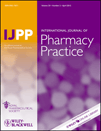The microbial contamination of pressurised metered-dose inhalers anonymously sourced from the South-East Queensland Australia community population
Abstract
Objectives To provide preliminary evidence regarding the presence, identity and level of microbial contamination of metered-dose inhalers sourced from the community. To correlate the level of microbial colonisation to the visible presence of debris on the interior and exterior surface of the device mouthpiece.
Methods In this exploratory study, 45 post-use de-identified pressurised metered-dose inhalers were collected from the South-East Queensland Australian community. Prior to swabbing, the presence of visible debris on the internal and external surfaces of the mouthpiece was recorded for each device. Swabs taken from external and inner surfaces of the mouthpiece of each device were streaked onto standard growth media for colony counts. Individual colonies were selected and enriched then streaked onto a range of differential and chromogenic media for differential identification.
Key findings A total of 36 post-use pressurised metered dose inhalers (80%) were shown to be colonised by microbes relative to unused devices (P = 0.01). Devices were primarily colonised by common respiratory flora, including Staphylococcus, Streptococcus and Haemophilus species. Of greatest concern was the positive identification of methicillin-resistant Staphylococcus aureus (18%) and extended-spectrum β-lactamase-producing Enterobacteriaceae (7%), Pseudomonas aerugonisa (2%) and Candida species (9%). The level of internal microbial contamination appeared to correlate to the presence of visible debris on the inside of the inhaler mouthpiece (P = 0.06) but not external debris (P = 0.59) while external contamination was not associated with internal (P = 0.99) or external debris (P = 0.63).
Conclusions These preliminary data suggest that pressurised metered dose inhalers are potential reservoirs for bacteria. While this study was not aimed at determining the impact that contaminated pressurised metered-dose inhalers may have on the user, future research is being conducted to address the implications of these findings and the consequences they may have for the population of users.




